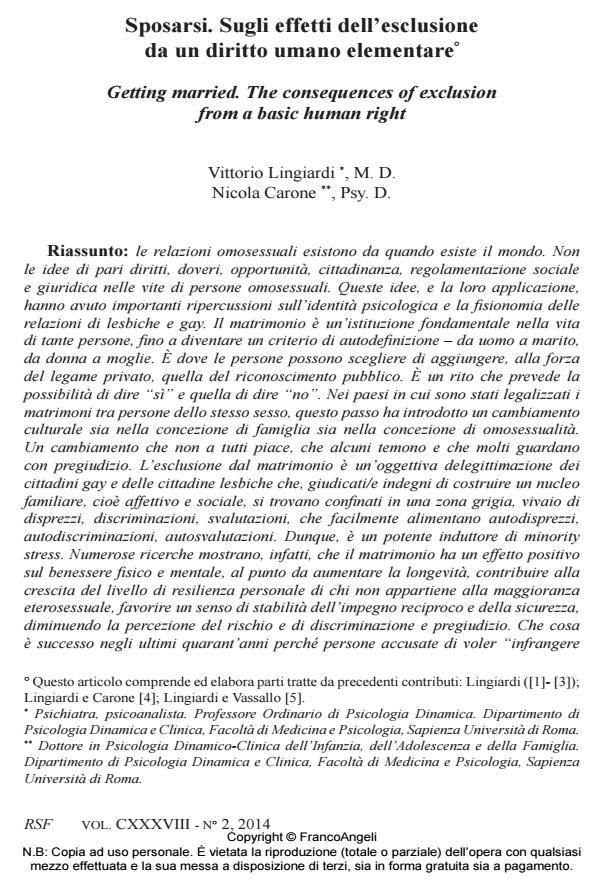Getting married. The consequences of exclusion from a basic human right
Journal title RIVISTA SPERIMENTALE DI FRENIATRIA
Author/s Vittorio Lingiardi, Nicola Carone
Publishing Year 2014 Issue 2014/2
Language Italian Pages 28 P. 85-112 File size 1660 KB
DOI 10.3280/RSF2014-002007
DOI is like a bar code for intellectual property: to have more infomation
click here
Below, you can see the article first page
If you want to buy this article in PDF format, you can do it, following the instructions to buy download credits

FrancoAngeli is member of Publishers International Linking Association, Inc (PILA), a not-for-profit association which run the CrossRef service enabling links to and from online scholarly content.
Homosexual relationships have always existed. However, the concepts of equal rights, responsibilities, opportunities, citizenship, social norms and legal regulation have not, in the past, been applied to the lives of homosexual people. Nowadays, these notions are put into practice and have strongly impacted lesbian and gay identities and the physiognomy of their relationships. Marriage is a basic social institution that generates a self-defining criterion: from woman to wife and from man to husband. This condition allows people to add a public recognition to the strength of a private bond. Marriage, as a rite, offers the possibility to say "yes" or "no". The countries, with legalised homosexual marriage, have spawned a cultural change in both the concepts of family and homosexuality. These developments are not always appreciated; some fear these changes and others look upon them with prejudice. The exclusion from marriage represents a factual delegitimisation of lesbian and gay citizens, considered as well, socially and emotionally not fit to foster a family. Hence, lesbian and gay people are confined to a grey area, font of social contempt, discrimination and critique, that can also breed self-contempt, self-discrimination and self-criticism. This form of exclusion is consequently a potent inducer of minority stress. Moreover, many studies underline the positive impact of marriage on physical and mental health. Marriage increases longevity, enhances the personal resilience of people who do not belong to the heterosexual majority, fosters a firm sense of mutual commitment and a feeling of security. Furthermore, it decreases the perception of risk, of discrimination and prejudice. What has been happening the last forty years? Why do the people - that were blamed for wanting to "infringe the model in which are combined the differences between sexes and the differences between generations" - now not only want to be recognized as full-fledged citizens, but also want to adopt the ‘family institution’ that contributed greatly to their delegitimisation?
Keywords: Marriage, homosexuality, homosexual parents, rights, minority stress, mental health.
Vittorio Lingiardi, Nicola Carone, Sposarsi. Sugli effetti dell’esclusione da un diritto umano elementare in "RIVISTA SPERIMENTALE DI FRENIATRIA" 2/2014, pp 85-112, DOI: 10.3280/RSF2014-002007